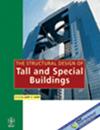城市边界层垂直层状结构及表面粗糙度参数研究
IF 1.3
3区 工程技术
Q3 CONSTRUCTION & BUILDING TECHNOLOGY
引用次数: 0
摘要
大气气流是影响城市建筑风荷载的主要因素。利用2013-2017年325 m北京气象塔连续观测资料,对城市边界层垂直分层结构和表面粗糙度参数进行了研究。根据局部相似理论和大气稳定性及局部摩擦速度的分析结果,可以确定80 m高度接近惯性子层底部,低于该高度的范围属于粗糙子层,140 m属于惯性子层,200 m和280 m属于混合层。80 m处的局部摩擦速度可以认为是相对可靠的摩擦速度值。此外,季节对局部摩擦速度的影响最小。根据近中性强风样本的对数拟合结果,得出要获得更准确的风速廓线,在选择拟合高度时应包括所有层。此外,表面粗糙度参数受风向和风速的影响。风向的变化与BMT周围的地形分布相对应,较高的风速范围可能更适用于估算表面粗糙度参数。本文章由计算机程序翻译,如有差异,请以英文原文为准。
Investigation of the vertically‐layered structure and surface roughness parameters of the urban boundary layer
Summary Atmospheric flow is the main factor affecting the wind load of urban buildings. The measured data observed continuously from the 325‐m‐tall Beijing Meteorological Tower (BMT) during 2013–2017 is employed to investigate the vertically‐layered structure and surface roughness parameters of the urban boundary layer. Based on the local similarity theory and analysis results of the atmospheric stability and local friction velocity, it can be determined that the height of 80 m is near the bottom of the inertial sub‐layer, the range below this height belongs to the roughness sub‐layer, 140 m belongs to the inertial sub‐layer, and 200 m and 280 m are in the mixing layer. The local friction velocity at 80 m can be considered a relatively reliable value as the friction velocity. Moreover, seasonal effect on local friction velocity is minimal. According to the fitting result of near‐neutral strong wind samples by the log‐law, it is concluded that to obtain a more accurate wind speed profile, all layers should be included when picking fitting heights. In addition, surface roughness parameters are affected by the wind direction and speed. The variation according to the wind direction corresponds to the topographical distribution surrounding the BMT, and the higher range of wind speed may be more applicable for estimating surface roughness parameters.
求助全文
通过发布文献求助,成功后即可免费获取论文全文。
去求助
来源期刊
CiteScore
5.30
自引率
4.20%
发文量
83
审稿时长
6-12 weeks
期刊介绍:
The Structural Design of Tall and Special Buildings provides structural engineers and contractors with a detailed written presentation of innovative structural engineering and construction practices for tall and special buildings. It also presents applied research on new materials or analysis methods that can directly benefit structural engineers involved in the design of tall and special buildings. The editor''s policy is to maintain a reasonable balance between papers from design engineers and from research workers so that the Journal will be useful to both groups. The problems in this field and their solutions are international in character and require a knowledge of several traditional disciplines and the Journal will reflect this.
The main subject of the Journal is the structural design and construction of tall and special buildings. The basic definition of a tall building, in the context of the Journal audience, is a structure that is equal to or greater than 50 meters (165 feet) in height, or 14 stories or greater. A special building is one with unique architectural or structural characteristics.
However, manuscripts dealing with chimneys, water towers, silos, cooling towers, and pools will generally not be considered for review. The journal will present papers on new innovative structural systems, materials and methods of analysis.

 求助内容:
求助内容: 应助结果提醒方式:
应助结果提醒方式:


